At present research in the Department is broadly organized into seven general areas.
Computer Engineering
Applied Networking Research Lab
Director: Jaudelice de Oliveira
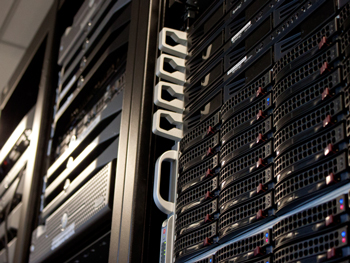
Applied Networking Research Lab (ANRL) projects focus on modeling and simulation as well as experimentation in wired, wireless and sensor networks. ANRL is the home of MuTANT, a Multi-Protocol Label Switched Traffic Engineering and Analysis Testbed composed of 10 high-end Cisco routers and several PC-routers, also used to study other protocols in data networks as well as automated network configuration and management. The lab also houses a sensor network testbed.
Learn More About the Applied Networking Research Lab
Bioimage Laboratory
Director:
Andrew Cohen
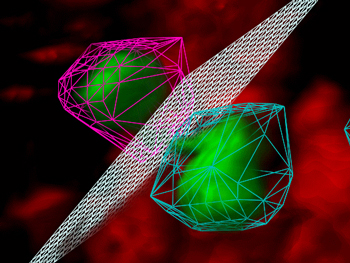
Research in the Bioimage Lab is focused on developing new computational techniques for analyzing and visualizing data from biological microscopy. Our work integrates algorithmic information theory with high throughput image processing and combines CPU and GPU approaches. Computer gaming hardware and software architectures are exploited to provide cost effective open source tools that optimally combine human knowledge and visual capabilities with computational sensing and analysis. Our work involves measuring developmental properties of stem cells, cancer cells and of sub-cellular organelles in 2-D and 3-D, with applications to cancer, developmental biology and regenerative medicine.
View a video highlighting the work of this lab.
Learn More About the Bioimage Laboratory
Drexel Network Modeling Laboratory
Director:
Steven Weber
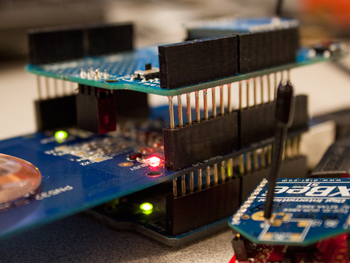
The Drexel Network Modeling Laboratory investigates problems in the mathematical modeling of communication networks, with specific focus on wireless ad hoc networks, wireless sensor networks, and supporting guaranteed delivery service models on best effort and multipath routed networks. Typical methodologies employed in our research include mathematical modeling, computer simulation, and performance optimization, often with the end goal of obtaining meaningful insights into network design principles and fundamental performance tradeoffs.
Learn More About the Network Modeling Laboratory
Drexel VLSI and Architecture Laboratory
Director:
Baris Taskin
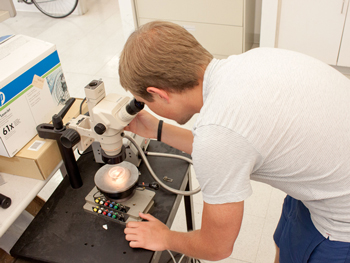
Drexel VLSI and Architecture Laboratory consists of a research group of computer engineers, electrical engineers and computer scientists tackling multiple aspects of design, analysis, implementation of integrated circuits and chip architectures. Suited with industrial design tools for integrated circuits, simulation tools and measurement beds, the VLSI and Architecture group can design and test digital and mixed-signal circuitry to verify the functionality of the discovered novel circuit and physical design principles. The group also develops new tools and methodologies to improve application performance and efficiency through optimization of both software and hardware architectures. The VLSI and Architecture group explores a gamut of workloads including high-performance computing, data center, GPU, and machine learning.
Learn More About the VLSI and Architecture Laboratory
Drexel Wireless Systems Laboratory
Director:
Kapil Dandekar
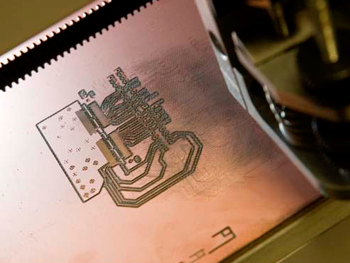
The Drexel Wireless Systems Laboratory (DWSL) contains an extensive suite of equipment for constructing, debugging, and testing prototype wireless communications systems. Major equipment within DWSL includes:
- Three software defined radio network testbeds (HYDRA, USRP, and WARP) for rapidly prototyping radio, optical and ultrasonic communications systems
- A TDK RF anechoic chamber and EMSCAN desktop antenna pattern measurement system
- A materials printer and printed circuit board milling machine for fabricating conformal antennas
- A wireless protocol conformance testing equipment from Aeroflex
The lab is also equipped with network analyzers, high speed signal generators, oscilloscopes, and spectrum analyzers as well as several Zigbee development platforms for rapidly prototyping sensor networks.
DWSL personnel also collaborate to create wearable, fabric based transceivers through collaboration with the Shima Seiki Haute Laboratory in the Drexel ExCITe Center. The knitting equipment at Drexel includes sixteen SDS-ONE APEX3 workstations and four state-of-the-art knitting machines. The workstations accurately simulate fabric construction and provide researchers and designers the opportunity to program, create and simulate textile prototypes, import CAD specifications of final products, and produce made-to-measure or mass-produced pieces on Shima Seiki knitting machines. For testing smart textiles for biomedical, DWSL personnel also have collaborators in the Center for Interdisciplinary Clinical Simulation and Practice (CICSP) in the Drexel College of Medicine which provides access to medical mannequin simulators.
Learn More About the Wireless Systems Laboratory
ExCITE Center
Shima Seiki Haute Laboratory
Electronic Design Automation Facility
Directors:
Prawat Nagvajara, Baris Taskin
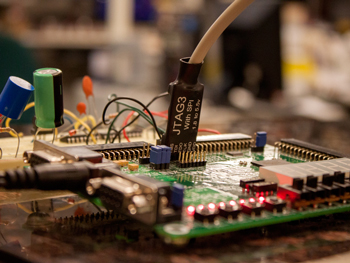
Industrial-grade electronic design automation software suite and intergraded design environment for digital, analog and mixed-signal systems development. Field Programmable Gate Array (FPGA) development hardware. Most up-to-date FPGA/embedded system development hardware kits. Printed circuit board production facility.
Testbed for Power/Performance Management of Enterprise Computing Systems
Director: Nagarajan Kandasamy

This computing testbed is used to validate techniques and algorithms aimed at managing the performance and power consumption of enterprise computing systems. The testbed comprises a rack of Dell 2950 and Dell 1950 PowerEdge servers, as well as assorted desktop machines, networked via a gigabit switch. Virtualization of this cluster is enabled by VMWare's ESX Server running the Linux RedHat kernel. It also comprises of a rack of ten Apple Xserve machines networked via a gigabit switch. These servers run the OS X Leopard operating systems and have access to a RAID with TBs of total disk capacity.
Control Robotics and Intelligent Systems
Data Fusion Laboratory
Director:
Steven Weber
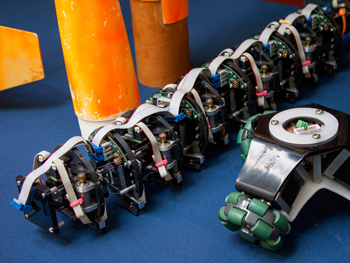
The Data Fusion Laboratory investigates problems in multisensory detection and estimation, with applications in robotics, digital communications, radar, and target tracking. Among the projects in progress:
- Computationally efficient parallel distributed detection architectures
- Data fusion for robot navigation, modulation recognition and RF scene analysis in time-varying environments
- Pattern recognition in biological data sequences and large arrays
- hardware realizations of data fusion architectures for target detection and target tracking.
Learn More About the Data Fusion Laboratory
Music and Entertainment Technology Laboratory
Director: Youngmoo Kim

The Music and Entertainment Technology Laboratory (MET-lab) is devoted to research in digital media technologies that will shape the future of entertainment, especially in the areas of sound and music. A subset of current research topics includes:
- Automated multi-track mixing
- Music emotion recognition
- Noise robust beat tracking
- Artist influence detection
- Brain-computer interfaces
Learn More About the Music and Entertainment Technology Laboratory
Cybersecurity
Data Fusion Laboratory
Director:
Steven Weber

The Data Fusion Laboratory investigates problems in multisensory detection and estimation, with applications in robotics, digital communications, radar, and target tracking. Among the projects in progress:
- Computationally efficient parallel distributed detection architectures
- Data fusion for robot navigation, modulation recognition and RF scene analysis in time-varying environments
- Pattern recognition in biological data sequences and large arrays
- hardware realizations of data fusion architectures for target detection and target tracking.
Learn More About the Data Fusion Laboratory
Drexel Network Modeling Laboratory
Director:
Steven Weber

The Drexel Network Modeling Laboratory investigates problems in the mathematical modeling of communication networks, with specific focus on wireless ad hoc networks, wireless sensor networks, and supporting guaranteed delivery service models on best effort and multipath routed networks. Typical methodologies employed in our research include mathematical modeling, computer simulation, and performance optimization, often with the end goal of obtaining meaningful insights into network design principles and fundamental performance tradeoffs.
Learn More About the Network Modeling Laboratory
Drexel Wireless Systems Laboratory
Director:
Kapil Dandekar

The Drexel Wireless Systems Laboratory (DWSL) contains an extensive suite of equipment for constructing, debugging, and testing prototype wireless communications systems. Major equipment within DWSL includes:
- Three software defined radio network testbeds (HYDRA, USRP, and WARP) for rapidly prototyping radio, optical and ultrasonic communications systems
- A TDK RF anechoic chamber and EMSCAN desktop antenna pattern measurement system
- A materials printer and printed circuit board milling machine for fabricating conformal antennas
- A wireless protocol conformance testing equipment from Aeroflex
The lab is also equipped with network analyzers, high speed signal generators, oscilloscopes, and spectrum analyzers as well as several Zigbee development platforms for rapidly prototyping sensor networks.
DWSL personnel also collaborate to create wearable, fabric based transceivers through collaboration with the Shima Seiki Haute Laboratory in the Drexel ExCITe Center. The knitting equipment at Drexel includes sixteen SDS-ONE APEX3 workstations and four state-of-the-art knitting machines. The workstations accurately simulate fabric construction and provide researchers and designers the opportunity to program, create and simulate textile prototypes, import CAD specifications of final products, and produce made-to-measure or mass-produced pieces on Shima Seiki knitting machines. For testing smart textiles for biomedical, DWSL personnel also have collaborators in the Center for Interdisciplinary Clinical Simulation and Practice (CICSP) in the Drexel College of Medicine which provides access to medical mannequin simulators.
Learn More About the Wireless Systems Laboratory
ExCITE Center
Shima Seiki Haute Laboratory
Electrophysics
Nanophotonics and Plasmonics Laboratory
Director: Bahram Nabet

The Drexel Nanophotonics and Plasmonics Lab is focused on characterization of optoelectronic, photonic and plasmonic devices. such as core-shell nanowires and HEMT devices. Also, we study the light and matter interactions in such devices for nano-scale lasers and photodetectors.
Learn More About the Nanophotonics and Plasmonics Laboratory
Drexel Wireless Systems Laboratory
Director:
Kapil Dandekar

The Drexel Wireless Systems Laboratory (DWSL) contains an extensive suite of equipment for constructing, debugging, and testing prototype wireless communications systems. Major equipment within DWSL includes:
- Three software defined radio network testbeds (HYDRA, USRP, and WARP) for rapidly prototyping radio, optical and ultrasonic communications systems
- A TDK RF anechoic chamber and EMSCAN desktop antenna pattern measurement system
- A materials printer and printed circuit board milling machine for fabricating conformal antennas
- A wireless protocol conformance testing equipment from Aeroflex
The lab is also equipped with network analyzers, high speed signal generators, oscilloscopes, and spectrum analyzers as well as several Zigbee development platforms for rapidly prototyping sensor networks.
DWSL personnel also collaborate to create wearable, fabric based transceivers through collaboration with the Shima Seiki Haute Laboratory in the Drexel ExCITe Center. The knitting equipment at Drexel includes sixteen SDS-ONE APEX3 workstations and four state-of-the-art knitting machines. The workstations accurately simulate fabric construction and provide researchers and designers the opportunity to program, create and simulate textile prototypes, import CAD specifications of final products, and produce made-to-measure or mass-produced pieces on Shima Seiki knitting machines. For testing smart textiles for biomedical, DWSL personnel also have collaborators in the Center for Interdisciplinary Clinical Simulation and Practice (CICSP) in the Drexel College of Medicine which provides access to medical mannequin simulators.
Learn More About the Wireless Systems Laboratory
ExCITE Center
Shima Seiki Haute Laboratory
Microwave-Photonics Device Laboratories
Director: Afshin Daryoush
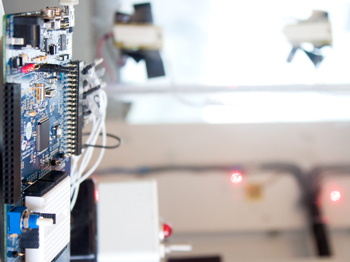
The laboratory is equipped with test and measurement equipment for high-speed analog and digital electronics and fiber optic systems. The test equipment includes:
- Network analyzers from Agilent (100kHz- 1.3 GHz and 45 Mhz-40 GHz), and Anritsu (45 MHz-6 GHz)
- Spectrum analyzers from Tektronix, HP, and Agilent with measurement capability of DC to 40 GHz and up to 90 GHz using external mixers
- Signal generators and communication channel modulators from HP, Rhode-Schwartz, Systron Donner, and Agilent
- Microwave power meter and sensor heads, assortment of passive and active microwave components up to 40 GHz
- Data pattern generator and BER tester up to 3Gb/s
- Optical spectrum analyzer from Anritsu and power meters from HP
- Single and multimode fiber optic based optical transmitter and receiver boards covering ITU channels at data rates up to 10Gb/s
- Passive optical components such as isolator, filter, couplers, optical connectors and fusion splicer
- LPKF milling machine for fabrication of printed circuit boards
- Wire-bonding and Cascade probe stations
- Intercontinental test fixtures for testing of MMIC circuits and solid-state transistors
- State-of-the-art microwave and electromagnetic CAD packages such as Agilent ADS, ANSYS HFSS, and COMSOL multi-physics module.
NanoPhotonics+ Lab
Director: Adam Fontecchio
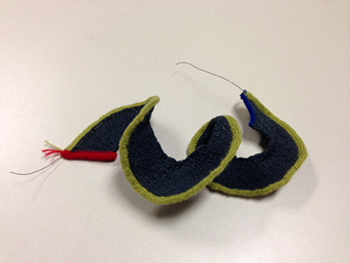
Our research is primarily in the area of nanophotonics with a focus on the nanoscale interaction of light with matter. Interests include:
- Liquid crystal/polymer composites for gratings, lenses and HOEs
- Liquid crystal interactions with surfaces and in confined nanospaces
- Alternative energy generation through novel photon interactions
- Ink-jet printed conducting materials for RF and photonic applications
- Creation and development of smart textiles technologies including soft interconnects, sensors, and wireless implementations.
Learn More About the NanoPhotonics+ Lab
Opto-Electro-Mechanical Laboratory

This lab concentrates on the system integration on optics, electronics, and mechanical components and systems, for applications in imaging, communication, and biomedical research. Research areas include:
- Programmable Imaging with Optical Micro-electrical-mechanical systems (MEMS), in which microscopic mirrors are used to image light into a single photodetector
- Pre-Cancerous Detection using White Light Spectroscopy, which performs a cellular size analysis of nuclei in tissue
- Free-space Optical Communication using Space Time Coding, which consists of diffused light for computer-to-computer communications, and also tiny lasers and detectors for chip-to-chip communication
- Magnetic Particle Locomotion, which showed that particles could swim in a uniform field
- Transparent Antennas using Polymer, which enables antennas to be printed through an ink-jet printer.
Plasma and Magnetics Laboratory
Director: Gary Friedman
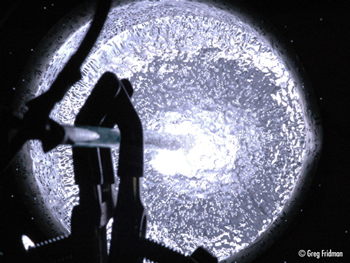
Research is focused on applications of electrical and magnetic technologies to biology and medicine. This includes the subjects of non-thermal atmospheric pressure plasma for medicine, magnetic manipulation of particles for drug delivery and bio-separation, development of miniature NMR sensors for cellular imaging and carbon nanotube cellular probes.
Image and Signal Processing and Interpretation
Adaptive Signal Processing and Information Theory Research Group
Director:
John Walsh

The Adaptive Signal Processing and Information Theory Research Group conducts research in the area of signal processing and information theory. Our main interests are belief/expectation propagation, turbo decoding and composite adaptive system theory. We are currently doing projects on the following topics:
- Delay mitigating codes for network coded systems
- Distributed estimation in sensor networks via expectation propagation
- Turbo speaker identification, iv) Performance and convergence of expectation propagation
- Investigating bounds for SINR performance of autocorrelation based channel shorteners.
Learn More About the Adaptive Signal Processing and Information Theory Research Group
Data Fusion Laboratory
Director:
Steven Weber

The Data Fusion Laboratory investigates problems in multisensory detection and estimation, with applications in robotics, digital communications, radar, and target tracking. Among the projects in progress:
- Computationally efficient parallel distributed detection architectures
- Data fusion for robot navigation, modulation recognition and RF scene analysis in time-varying environments
- Pattern recognition in biological data sequences and large arrays
- hardware realizations of data fusion architectures for target detection and target tracking.
Learn More About the Data Fusion Laboratory
Drexel Wireless Systems Laboratory
Director:
Kapil Dandekar

The Drexel Wireless Systems Laboratory (DWSL) contains an extensive suite of equipment for constructing, debugging, and testing prototype wireless communications systems. Major equipment within DWSL includes:
- Three software defined radio network testbeds (HYDRA, USRP, and WARP) for rapidly prototyping radio, optical and ultrasonic communications systems
- A TDK RF anechoic chamber and EMSCAN desktop antenna pattern measurement system
- A materials printer and printed circuit board milling machine for fabricating conformal antennas
- A wireless protocol conformance testing equipment from Aeroflex
The lab is also equipped with network analyzers, high speed signal generators, oscilloscopes, and spectrum analyzers as well as several Zigbee development platforms for rapidly prototyping sensor networks.
DWSL personnel also collaborate to create wearable, fabric based transceivers through collaboration with the Shima Seiki Haute Laboratory in the Drexel ExCITe Center. The knitting equipment at Drexel includes sixteen SDS-ONE APEX3 workstations and four state-of-the-art knitting machines. The workstations accurately simulate fabric construction and provide researchers and designers the opportunity to program, create and simulate textile prototypes, import CAD specifications of final products, and produce made-to-measure or mass-produced pieces on Shima Seiki knitting machines. For testing smart textiles for biomedical, DWSL personnel also have collaborators in the Center for Interdisciplinary Clinical Simulation and Practice (CICSP) in the Drexel College of Medicine which provides access to medical mannequin simulators.
Learn More About the Wireless Systems Laboratory
ExCITE Center
Shima Seiki Haute Laboratory
Ecological and Evolutionary Signal-processing and Informatics Laboratory
Director:
Gail Rosen
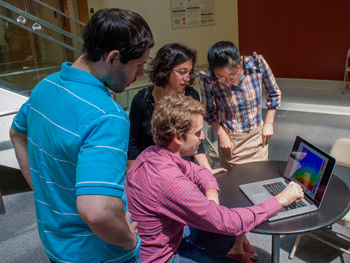
The Ecological and Evolutionary Signal-processing and Informatics Laboratory (EESI) seeks to solve problems in high-throughput genomics and engineer better solutions for biochemical applications. The lab's primary thrust is to enhance the use of high-throughput DNA sequencing technologies with pattern recognition and signal processing techniques. Applications include assessing the organism content of an environmental sample, recognizing/classifying potential and functional genes, inferring environmental factors and inter-species relationships, and inferring microbial evolutionary relationships from short-read DNA/RNA fragments. The lab also investigates higher-level biological systems such as modeling and controlling chemotaxis, the movement of cells.
Learn More About the Ecological and Evolutionary Signal-processing and Informatics Laboratory
Music and Entertainment Technology Laboratory
Director: Youngmoo Kim

The Music and Entertainment Technology Laboratory (MET-lab) is devoted to research in digital media technologies that will shape the future of entertainment, especially in the areas of sound and music. A subset of current research topics includes:
- Automated multi-track mixing
- Music emotion recognition
- Noise robust beat tracking
- Artist influence detection
- Brain-computer interfaces
Learn More About the Music and Entertainment Technology Laboratory
Power Engineering and Energy
Drexel University Nuclear Engineering Education Lab
Director:
Christopher Peters

The field of nuclear engineering encompasses a wide spectrum of occupations, including nuclear reactor design, medical imaging, homeland security, and oil exploration. The Drexel University Nuclear Engineering Education Laboratory (DUNEEL) provides fundamental hands on understanding for power plant design and radiation detection and analysis. Software based study for power plant design, as well as physical laboratory equipment for radiation detection, strengthen the underlying concepts used in nuclear engineering such that the student will comprehend and appreciate the basic concepts and terminology used in various nuclear engineering professions. Additionally, students use the laboratory to develop methods for delivering remote, live time radiation detection and analysis. The goal of DUNEEL is to prepare students for potential employment in the nuclear engineering arena.
Electric Power Engineering Center
Directors: Karen Miu, Dagmar Niebur

This newly established facility makes possible state-of-the-art research in a wide variety of areas, ranging from detailed theoretical model study to experimental investigation in its high voltage laboratories. The mission is to advance and apply scientific and engineering knowledge associated with the generation, transmission, distribution, use, and conservation of electric power. In pursuing these goals, this center works with electric utilities, state and federal agencies, private industries, nonprofit organizations and other universities on a wide spectrum of projects. Research efforts, both theoretical and experimental, focus on the solution of those problems currently faced by the electric power industry. Advanced concepts for electric power generation are also under investigation to ensure that electric power needs will be met at the present and in the future.
Learn More About the Electric Power Engineering Center
Power Electronics Research Laboratory

The Power Electronics Research Laboratory (PERL) is involved in circuit and design simulation, device modeling and simulation, and experimental testing and fabrication of power electronic circuits. The research and development activities include electrical terminations, power quality, solar photovoltaic systems, GTO modeling, protection and relay coordination, and solid-state circuit breakers. The analysis tools include EMPT, SPICE, and others, which have been modified to incorporate models of such controllable solid-state switches as SCRs, GTOs, and MOSFETs. These programs have a wide variety and range of modeling capabilities used to model electromagnetics and electromechanical transients ranging from microseconds to seconds in duration. The PERL is a fully equipped laboratory with 42 kVA AC and 70 kVA DC power sources and data acquisition systems, which have the ability to display and store data for detailed analysis. Some of the equipment available is a distribution and HV transformer and three phase rectifiers for power sources and digital oscilloscopes for data measuring and experimental analysis. Some of the recent studies performed by the PERL include static VAR compensators, power quality of motor controllers, solid-state circuit breakers, and power device modeling which have been supported by PECO, GE, Gould, and EPRI.
Telecommunications and Networking
Adaptive Signal Processing and Information Theory Research Group
Director:
John Walsh

The Adaptive Signal Processing and Information Theory Research Group conducts research in the area of signal processing and information theory. Our main interests are belief/expectation propagation, turbo decoding and composite adaptive system theory. We are currently doing projects on the following topics:
- Delay mitigating codes for network coded systems
- Distributed estimation in sensor networks via expectation propagation
- Turbo speaker identification, iv) Performance and convergence of expectation propagation
- Investigating bounds for SINR performance of autocorrelation based channel shorteners.
Learn More About the Adaptive Signal Processing and Information Theory Research Group
Applied Networking Research Lab
Director:
Jaudelice de Oliveira

Applied Networking Research Lab (ANRL) projects focus on modeling and simulation as well as experimentation in wired, wireless and sensor networks. ANRL is the home of MuTANT, a Multi-Protocol Label Switched Traffic Engineering and Analysis Testbed composed of 10 high-end Cisco routers and several PC-routers, also used to study other protocols in data networks as well as automated network configuration and management. The lab also houses a sensor network testbed.
Learn More About the Applied Networking Research Lab
Data Fusion Laboratory
Director:
Steven Weber

The Data Fusion Laboratory investigates problems in multisensory detection and estimation, with applications in robotics, digital communications, radar, and target tracking. Among the projects in progress:
- Computationally efficient parallel distributed detection architectures
- Data fusion for robot navigation, modulation recognition and RF scene analysis in time-varying environments
- Pattern recognition in biological data sequences and large arrays
- hardware realizations of data fusion architectures for target detection and target tracking.
Learn More About the Data Fusion Laboratory
Drexel Network Modeling Laboratory
Director:
Steven Weber

The Drexel Network Modeling Laboratory investigates problems in the mathematical modeling of communication networks, with specific focus on wireless ad hoc networks, wireless sensor networks, and supporting guaranteed delivery service models on best effort and multipath routed networks. Typical methodologies employed in our research include mathematical modeling, computer simulation, and performance optimization, often with the end goal of obtaining meaningful insights into network design principles and fundamental performance tradeoffs.
Learn More About the Network Modeling Laboratory